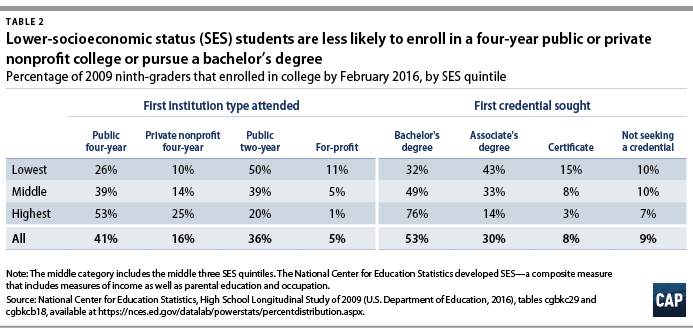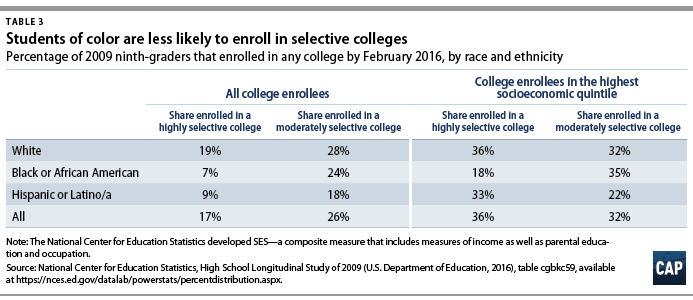It’s tempting to think that America has largely solved its problems surrounding access to postsecondary education. The rate at which recent high school graduates enroll in college is around an all-time high. There are more Americans who have started college—but have not finished—than Americans who have dropped out of high school. These trends have increasingly helped shift postsecondary education policy discussions toward issues of retention and completion.
While getting college students to graduation is critical, new federal data show that the United States still fails miserably at providing equitable access to learning beyond high school, particularly in terms of socio-economic status. Students from the lowest levels of socio-economic status (SES) enroll in college at a rate that’s 60 percent the level of their best-off peers. When they do enroll, they are far more likely to attend a nonselective college or pursue something less than a bachelor’s degree. This is particularly striking for black students in the highest SES group, who are still half as likely to attend a highly selective college as their white peers. And this story does not hinge on academic ability: The least-affluent students with good grades and scores on an assessment of math skills enroll in college at about the same rate as the best-off students with middling academic accomplishments.
These findings come from the latest follow-up to the National Center for Education Statistics’ High School Longitudinal Study of 2009 (HLS). The survey tracks more than 23,000 students who were in ninth grade in 2009, showing how many enrolled in or completed college by February 2016.
This column presents four findings about college access from these new data. It is important to note that breakdowns by socio-economic status in the data are not solely a measure of income. The National Center for Education Statistics uses a composite measure that also considers the education level and occupation of students’ parents.
1. There are major gaps in college-going by socio-economic status
Overall, 70 percent of students who were in ninth grade in 2009 had enrolled in some form of postsecondary education by February 2016. But college-going was not evenly distributed across SES quintiles. More than 90 percent of students in the highest SES quintile enrolled in college, compared with just 56 percent of those in the lowest SES quintile.

2. Higher-achieving, low-SES students enroll in college at lower rates than their low-achieving, high-SES peers
High-achieving students from lesser means offer the most stark example of the pernicious effect of money and class on college opportunity. The new data show that the students in the lowest SES quintile with the highest scores on a math skills assessment developed for the survey enroll in college at a rate 18 percentage points lower than their peers in the highest SES quintile with similarly high scores.
But it is important to look beyond the high-achieving, low-SES students. Otherwise, it’s easy to ignore the extent to which the postsecondary education system closes off opportunities for students who come from less privileged backgrounds unless they have top-notch academic outcomes—even as wealthier students with so-so grades and test scores benefit from the opportunity to attend college.
Eighty-eight percent of the students in the highest SES quintile with a high school GPA from 2.0 to 2.99 enrolled in college, compared with just 61 percent of students in the lowest SES quintile with the same marks. Similarly, 73 percent of the students in the highest SES quintile with the lowest math test scores enrolled in college—nearly double the 41 percent of students in the lowest SES quintile.

3. Students in lower SES quintiles are less likely to enroll in four-year colleges and bachelor’s degree programs
Setting aside gaps in the rates at which students enroll in postsecondary education, there are significant differences in the types of schools in which students enroll, and the credentials they pursue, based on their socio-economic status. As Table 3 shows, nearly 80 percent of students in the highest SES quintile enroll in a four-year public or private nonprofit college, and 90 percent pursue a bachelor’s degree. By contrast, just 36 of the students in the lowest SES quintile attend these types of schools, with about the same share seeking a bachelor’s degree.

Although many types of postsecondary credentials provide an economic return, these results are concerning. Public and private nonprofit four-year institutions have higher graduation rates than other types of colleges. And bachelor’s degrees, on average, provide a much higher earnings boost than other types of postsecondary credentials.
4. Higher-SES black and Latinx students are less likely to attend selective colleges than their white peers
While selective colleges enroll only a small share of students in higher education, they have an outsize role in America’s postsecondary education system. That’s because these schools have greater resources on which to draw than do most other types of institutions, and they can put students on the path to particularly prestigious job opportunities that may not be as available to those who attend less selective institutions. And these benefits are particularly important for underrepresented students. This is not to say that policy should focus only on elite colleges but instead that ensuring sufficient diversity at these institutions is an important component of any policy to improve the higher education system.
Unfortunately, Table 4 shows that there are worrisome gaps by race in access to selective colleges. A white student is two times more likely to attend a selective college than a black or Latinx student.* The gap between white and black students does not dissipate even when looking only at students in the highest SES quintile. A white student in this group is two times more likely to attend a highly selective college than a black student in the highest SES quintile.

Conclusion
Not enough time has passed for the follow-up to the 2009 HLS to show how these gaps in postsecondary access may affect college completion. Students in ninth grade in 2009 would have been in the high school graduating class of 2013, meaning those who went straight to college would finish a bachelor’s degree in spring 2017, well after this end of this follow-up’s scope in 2016.
But initial indications of college completion are not promising. By February 2016, a little more than one-fifth of students who had enrolled in college had left without finishing a program. The results are particularly worrisome for black students. One-third of black students at all SES levels who attended college at some point were not enrolled by February 2016. This includes one-quarter of black students in the highest SES quintile.
These results—as well as those detailed above—are unacceptable. And they cannot be fixed by merely tinkering with the existing system. That’s why the Center for American Progress released a new proposal called Beyond Tuition in June. It calls for improving college affordability, access, and completion by providing students a path to debt-free degrees and by ensuring that colleges put a greater focus on supporting low-income students; students of color; and other students, such as those with disabilities and veterans, who tend to have lower rates of postsecondary entry and completion. Taking this kind of bold action is a necessary step toward ensuring that the United States does not continue to condemn millions of the most vulnerable students to an educational system that serves them so poorly.
* This column uses “black” to refer to students who are classified as “black or African American” in the underlying data. Similarly, it uses “Latinx” to describe students who are classified as “Hispanic, Latino, or Latina.”
Ben Miller is the senior director for Postsecondary Education at the Center for American Progress.